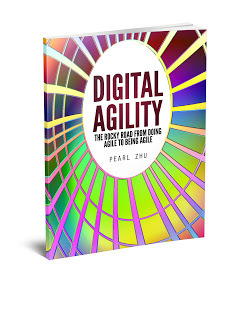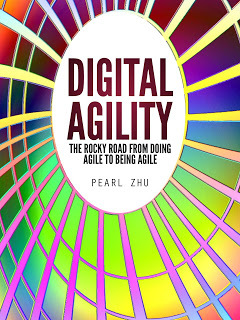Pearl Zhu's Blog, page 1329
June 11, 2016
The Monthly Decision Making Insight June, 2016
Decision making is the arena across the art and science; gut feeling and data driven, confidence and humility.
 Making a decision is one of the significant tasks for business leadership, however, the high ratio of strategic decisions have been made poorly and cause the catastrophic effect. How to avoid such decision pitfalls, to make effective decisions both strategically and tactically?
Making a decision is one of the significant tasks for business leadership, however, the high ratio of strategic decisions have been made poorly and cause the catastrophic effect. How to avoid such decision pitfalls, to make effective decisions both strategically and tactically?
How to Achieve Decision Making Excellence? Making decision is one of the most significant tasks for leaders, managers and digital professionals today. There are strategic decisions, operational decisions, and tactical decisions. The reason decision making is often a difficult task because it is contextual and situational, it takes a unique individual to understand a situation and relate it to the present. There are many variables in complex decision making, there are tradeoffs you have to leverage, and there is no magic formula to follow. So what are some effective decision-making mentalities, which tools should you apply, and what processes are necessary to achieve decision making excellence?
Three Aspects in Making Effective Decisions At today’s digital new normal -uncertainty, complexity, velocity, and ambiguity, the capability to make effective decisions becomes a more crucial leadership competency. There is fuzziness in the decision because there is fuzziness in conflicting criteria. An effective decision can be defined as an action you take that is logically consistent with the alternative you perceive, the information you get and the preference you have.
“Digital Valley” Chapter IV Book Preview: Decision Wisdom The majority of leaders and professional spend a significant amount of time on making large or small decisions in the work and life. It takes wisdom, not just the intelligence to make effective decisions. There is fuzziness in the decisions because there is fuzziness in conflicting criteria. At the Digital Era, making data-based decisions means to leverage analytical thinking, advanced analytic tools, the human’s intuition, and add the “wisdom’ in the decision process to improve the overall effectiveness of decision making.
The CIO’s Digital Agenda XXXXX: Leveraging IT as a Business Decision Influencer: Fundamentally, the purpose of IT organization is to ensure the right information going to the right people at the right time and location in order to make the right decision. Indeed, IT is a key business decision influencer at information-explosion era, but more specifically, how does IT make an impact on the business decision, and how can IT improve business’s decision-making capabilities and effectiveness?
 Three Questions to Assess a Person’s “Decisiveness” At today’s digital dynamic with increased velocity, complexity, unpredictability, there is a need for a faster response to changes in the business and industry based on effective and efficient decision making which is one of the most important tasks for both digital leaders and digital professionals at either strategic, operational, or tactical level. How is that possible? What’s the digital way to make the right decision? And how to assess a person’s “decisiveness”?
Three Questions to Assess a Person’s “Decisiveness” At today’s digital dynamic with increased velocity, complexity, unpredictability, there is a need for a faster response to changes in the business and industry based on effective and efficient decision making which is one of the most important tasks for both digital leaders and digital professionals at either strategic, operational, or tactical level. How is that possible? What’s the digital way to make the right decision? And how to assess a person’s “decisiveness”?
The blog is a dynamic book flowing with your thought; growing through your dedication; sharing your knowledge; conveying your wisdom, and making influence through touching the hearts and connecting the minds across the globe. The “Future of CIO” Blog has reached 1.3 million page views with about #2800 blog posting. Among 59+ different categories of leadership, management, strategy, digitalization, change/talent, etc. Blogging is not about writing, but about thinking and innovating the new ideas; it’s not just about WHAT to say, but about WHY to say, and HOW to say it. It reflects the color and shade of your thought patterns, and it indicates the peaks and curves of your thinking waves. Unlike pure entertainment, quality and professional content takes time for digesting, contemplation and engaging, and therefore, it takes the time to attract the "hungry minds" and the "deep souls." It’s the journey to amplify diverse voices and deepen digital footprints, and it's the way to harness your innovative spirit.
Follow us at: @Pearl_Zhu
 Making a decision is one of the significant tasks for business leadership, however, the high ratio of strategic decisions have been made poorly and cause the catastrophic effect. How to avoid such decision pitfalls, to make effective decisions both strategically and tactically?
Making a decision is one of the significant tasks for business leadership, however, the high ratio of strategic decisions have been made poorly and cause the catastrophic effect. How to avoid such decision pitfalls, to make effective decisions both strategically and tactically?
How to Achieve Decision Making Excellence? Making decision is one of the most significant tasks for leaders, managers and digital professionals today. There are strategic decisions, operational decisions, and tactical decisions. The reason decision making is often a difficult task because it is contextual and situational, it takes a unique individual to understand a situation and relate it to the present. There are many variables in complex decision making, there are tradeoffs you have to leverage, and there is no magic formula to follow. So what are some effective decision-making mentalities, which tools should you apply, and what processes are necessary to achieve decision making excellence?
Three Aspects in Making Effective Decisions At today’s digital new normal -uncertainty, complexity, velocity, and ambiguity, the capability to make effective decisions becomes a more crucial leadership competency. There is fuzziness in the decision because there is fuzziness in conflicting criteria. An effective decision can be defined as an action you take that is logically consistent with the alternative you perceive, the information you get and the preference you have.
“Digital Valley” Chapter IV Book Preview: Decision Wisdom The majority of leaders and professional spend a significant amount of time on making large or small decisions in the work and life. It takes wisdom, not just the intelligence to make effective decisions. There is fuzziness in the decisions because there is fuzziness in conflicting criteria. At the Digital Era, making data-based decisions means to leverage analytical thinking, advanced analytic tools, the human’s intuition, and add the “wisdom’ in the decision process to improve the overall effectiveness of decision making.
The CIO’s Digital Agenda XXXXX: Leveraging IT as a Business Decision Influencer: Fundamentally, the purpose of IT organization is to ensure the right information going to the right people at the right time and location in order to make the right decision. Indeed, IT is a key business decision influencer at information-explosion era, but more specifically, how does IT make an impact on the business decision, and how can IT improve business’s decision-making capabilities and effectiveness?
 Three Questions to Assess a Person’s “Decisiveness” At today’s digital dynamic with increased velocity, complexity, unpredictability, there is a need for a faster response to changes in the business and industry based on effective and efficient decision making which is one of the most important tasks for both digital leaders and digital professionals at either strategic, operational, or tactical level. How is that possible? What’s the digital way to make the right decision? And how to assess a person’s “decisiveness”?
Three Questions to Assess a Person’s “Decisiveness” At today’s digital dynamic with increased velocity, complexity, unpredictability, there is a need for a faster response to changes in the business and industry based on effective and efficient decision making which is one of the most important tasks for both digital leaders and digital professionals at either strategic, operational, or tactical level. How is that possible? What’s the digital way to make the right decision? And how to assess a person’s “decisiveness”?
The blog is a dynamic book flowing with your thought; growing through your dedication; sharing your knowledge; conveying your wisdom, and making influence through touching the hearts and connecting the minds across the globe. The “Future of CIO” Blog has reached 1.3 million page views with about #2800 blog posting. Among 59+ different categories of leadership, management, strategy, digitalization, change/talent, etc. Blogging is not about writing, but about thinking and innovating the new ideas; it’s not just about WHAT to say, but about WHY to say, and HOW to say it. It reflects the color and shade of your thought patterns, and it indicates the peaks and curves of your thinking waves. Unlike pure entertainment, quality and professional content takes time for digesting, contemplation and engaging, and therefore, it takes the time to attract the "hungry minds" and the "deep souls." It’s the journey to amplify diverse voices and deepen digital footprints, and it's the way to harness your innovative spirit.
Follow us at: @Pearl_Zhu
Published on June 11, 2016 23:04
“Digital Agility- The Rocky Road from Doing Agile to Being Agile” Book Preview
 The term ‘Agile’ is derived from ‘The Manifesto for Agile Software Development’ which describes a collaborative way of working based on a set of twelve principles that has come to mean early delivery of business value. The problem is people do not have a profound understanding of Agile principles and philosophy behind a set of Agile framework or tools. Most of the times they use the word "agile" when in fact they are talking about agile software development. The best way to fail is thinking that you will implement agile inside a business unit without taking into account the whole enterprise. Agile needs to be the philosophy to perceive multidimensional business values. Make the effort at the leadership and portfolio level to qualify and quantify value in terms of both strategic value and tactical value; direct revenue and indirect (vision/values/culture) terms is the first step to crafting high-level strategic intents. When faced with two or more alternatives that deliver roughly the same value, take the path that makes future change easier. Once benefits of agile are visible and understood, a domino effect takes over, the organization as a whole becomes “agiler.” The purpose of the book “Digital Agility” is to:
The term ‘Agile’ is derived from ‘The Manifesto for Agile Software Development’ which describes a collaborative way of working based on a set of twelve principles that has come to mean early delivery of business value. The problem is people do not have a profound understanding of Agile principles and philosophy behind a set of Agile framework or tools. Most of the times they use the word "agile" when in fact they are talking about agile software development. The best way to fail is thinking that you will implement agile inside a business unit without taking into account the whole enterprise. Agile needs to be the philosophy to perceive multidimensional business values. Make the effort at the leadership and portfolio level to qualify and quantify value in terms of both strategic value and tactical value; direct revenue and indirect (vision/values/culture) terms is the first step to crafting high-level strategic intents. When faced with two or more alternatives that deliver roughly the same value, take the path that makes future change easier. Once benefits of agile are visible and understood, a domino effect takes over, the organization as a whole becomes “agiler.” The purpose of the book “Digital Agility” is to:
Share the insight about agile philosophy and mindsetsClarify a set of agile principles and disciplinesDevelop the best and next agile practices to scale upDescribe potential agile pitfalls and how to prevent themConnect the agile dots to build a creative working environmentMeasure the right things about agile and measure them rightSum up agile maturity from multidimensional perspectivesInspire healthy debates to move agile up to the next level of maturity
 From “doing Agile to being agile” is a rocky road, not a straight path: Agile is direction, not a destination. Transforming to “Being Agile” means the business knows the direction they want to go on, and as people start “putting on” the agile mindset, discover new ways of working, collaborating, delivering value, they inspect and adapt in that journey by overcoming the frictions and challenges. You have to keep things rolling, to make agile not just a methodology to manage projects, but a principle instilled into a healthy culture to run the business more effectively. To move from Waterfall to Agile is not an act of one day. It is a journey. And as long as the journey is coming to a place where we can call the organization actually Agile, Waterfall and Agile do co-exist. Some organizations stop moving and remain in the hybrid state and some just turn back to go on the previous state of the waterfall and few actually reach the destination of the Agile world. So, hybrid organizations are the reality.
From “doing Agile to being agile” is a rocky road, not a straight path: Agile is direction, not a destination. Transforming to “Being Agile” means the business knows the direction they want to go on, and as people start “putting on” the agile mindset, discover new ways of working, collaborating, delivering value, they inspect and adapt in that journey by overcoming the frictions and challenges. You have to keep things rolling, to make agile not just a methodology to manage projects, but a principle instilled into a healthy culture to run the business more effectively. To move from Waterfall to Agile is not an act of one day. It is a journey. And as long as the journey is coming to a place where we can call the organization actually Agile, Waterfall and Agile do co-exist. Some organizations stop moving and remain in the hybrid state and some just turn back to go on the previous state of the waterfall and few actually reach the destination of the Agile world. So, hybrid organizations are the reality. Agile is neither just a methodology nor a set of practices, Agile is a state of mind. It’s the basic underlying principles of Agile! You can not expect big bang mindset change so you need to start with agile philosophy and some initial practices that pay off and reinforce, a mindset change is more difficult of a change and involves coaching, training, teaching and important discussions around what Agile is to the team, department, and company coaching, training, teaching and important discussions around what Agile is to the team, department, and company. Ultimately, all aspects of the enterprise from strategic planning to the most atomic level tasks must embrace agile for optimal effect.
Follow us at: @Pearl_Zhu
Published on June 11, 2016 23:02
June 10, 2016
Change Management Insight: Five Types of “DNA” to Enforce Organizational Maturity
 Change is inevitable, organizational change has become a common practice within an organization, but too often changes are made as a reaction to outer impulses, crisis, and demands. This is the bureaucracy’s way of meeting the challenges. How to understand the mentalities behind the change as the first step, in order to fine tune the process of Change Management, and overcome the obstacles to managing a digital transformation smoothly?
Change is inevitable, organizational change has become a common practice within an organization, but too often changes are made as a reaction to outer impulses, crisis, and demands. This is the bureaucracy’s way of meeting the challenges. How to understand the mentalities behind the change as the first step, in order to fine tune the process of Change Management, and overcome the obstacles to managing a digital transformation smoothly?
Five Types of “DNA” to Enforce Digital Organizational MaturityHow to Build a Customer-Centric Culture: Digital is the age of customers. Building customer-centricity consistently in a way that delivers the right experiences to the right customers at the right times is, in most companies, enormously complicated. Changing the culture and breaking down silos is one of the biggest challenges. How to build a customer-centric culture and improve organizational maturity?
How to Shape an Agile Culture: Every forward-looking organization is transforming from doing Agile to being Agile while the fundamental to such shift is the culture thing. Every experienced professional will be agile enough to say that few things are vital for creating an agile organization, such as seamless communication, focus on innovation, harnessing collaboration and employee empowerment. But to digital deeper, what's fundamental for such shift, it’s about shaping the collective mindset, attitude, and behavior to adapt to the increasing change environment and take action more proactively.
A Culture of Continuous Improvement? All organizations have a culture. That culture is a display of collective behavior. It is influenced and shaped by the interaction between employees, management, and their environment. The result is a set of norms and values that determine how people will behave and relate to one another in a particular setting. Culture is a mindset, attitude, and competency of an organization. Changing the organizational culture, however, is not so easily done because traditions are closely held as norms, values, and beliefs. In addition, the nature of organizational structure—the hierarchy—can slow the process of review and adaptation. We all know the old saying: Culture eats strategy for lunch. Hence, how to shape a continuous-improvement culture, who are the change agent, and what are the best scenario with logic steps in managing such culture transition?
The culture of Execution: We all heard the saying ‘culture eats strategy for lunch’, so what is the better culture for execution: setting reasonable objectives that can be achieved or setting ambitious, stretch objectives that even if not fully accomplished? How about personal commitment or team performance, and how to shape a culture of execution?
 A Cohesive Culture Culture is the collective mindset, attitude, and behavior. Culture is part passion, part commitment, and part faith. It's the passion and excitement about what we're doing and how we're doing it. It's the synergy of the team, the managers and business leaders. Therefore, a cohesive culture creates team synergy, catalyze digital transformation and improve overall organizational maturity. Blogging is not about writing, but about thinking; it’s not just about WHAT to say, but about WHY to say, and HOW to say it. It reflects the color and shade of your thought patterns, and it indicates the peaks and curves of your thinking waves. Unlike pure entertainment, quality and professional content takes time for digesting, contemplation and engaging, and therefore, it takes the time to attract the "hungry minds" and the "deep souls." It’s the journey to amplify your voice, deepen your digital footprints, and match your way for human progression.Follow us at: @Pearl_Zhu
A Cohesive Culture Culture is the collective mindset, attitude, and behavior. Culture is part passion, part commitment, and part faith. It's the passion and excitement about what we're doing and how we're doing it. It's the synergy of the team, the managers and business leaders. Therefore, a cohesive culture creates team synergy, catalyze digital transformation and improve overall organizational maturity. Blogging is not about writing, but about thinking; it’s not just about WHAT to say, but about WHY to say, and HOW to say it. It reflects the color and shade of your thought patterns, and it indicates the peaks and curves of your thinking waves. Unlike pure entertainment, quality and professional content takes time for digesting, contemplation and engaging, and therefore, it takes the time to attract the "hungry minds" and the "deep souls." It’s the journey to amplify your voice, deepen your digital footprints, and match your way for human progression.Follow us at: @Pearl_Zhu
Published on June 10, 2016 23:51
"CIO Master" Book Tuning XXXVI: Three Aspects of IT Performance Measurement
IT leaders must keep in mind which KPIs best measure IT ability to deliver business value.
 IT organizations today intend to reinvent the tarnished image since traditional IT is still being labeled as a cost center and support desk only. Because its business value hasn’t been conveyed in a structured or quantified way yet. And it only focuses on measuring internal value (cost efficiency, internal customer satisfaction), or the things only internal IT is interested in. The measures often do not reflect the full set of value IT can bring to accelerate business growth or delight end customers. If we can only manage what we measure, the issue here is how to measure IT performance effectively?
IT organizations today intend to reinvent the tarnished image since traditional IT is still being labeled as a cost center and support desk only. Because its business value hasn’t been conveyed in a structured or quantified way yet. And it only focuses on measuring internal value (cost efficiency, internal customer satisfaction), or the things only internal IT is interested in. The measures often do not reflect the full set of value IT can bring to accelerate business growth or delight end customers. If we can only manage what we measure, the issue here is how to measure IT performance effectively?
IT leaders must keep in mind which KPIs best measure IT ability to deliver business value: Continually accelerating changes in IT consumption and production requires faster responses and better performance metrics. It’s dangerous to impose metrics just because the focus on what’s measurable is manageable. IT Metrics has to evolve from being a cost center to becoming a revenue generator. The only way to do this is to show a clear link to top executives between IT efficiency and productivity/ top-line revenues. This is an important step to building IT reputation as a strategic business partner.
Present a methodology to acquire the “appropriate” contextual measurement items: Historically, performance measurement systems for most businesses have been financing driven. However, in many business situations, financial indicators only cover part of the story. Your measures should cover all areas that contribute to value creation including service quality, employee engagement, customer satisfaction and financial outcomes. Also, there’re always two sides of measurement. The measures to motivate teams to achieve more and the measures to distract management from the ultimate business goals. KPIs and the associated metrics drive priorities and behaviors, therefore, KPI setting should focus on achieving the ultimate goals of business as a whole. Contextually, the measurement method is to persuade management the progress of strategy execution. There are indeed qualitative objectives where the basis for rating performance is the set of criteria that address the question: “what does it mean to achieve this objective?” In some cases, these may also be action plans. Further, to populate the scorecard with too many metrics for the sake of measurement is also unproductive. Keep them focused on drivers of performance and, appropriately weighted.
 Cost Optimization Metrics: Every new technology adopted must facilitate business but also bring down the incremental cost of growth and the time to market. That should be the true metric for the IT leaders – how have they been able to impact the top and bottom-line and facilitate growth and competitiveness. IT value is measured by optimization and consumption of IT assets in support of the business solutions that are identified within the organization's revenue producing streams. With the right set of metrics to measure the right things, IT leaders don't just need to stay in tune with the times, rather stay ahead of the curve, and be able to allocate/align their capabilities to what the business really needs.
Cost Optimization Metrics: Every new technology adopted must facilitate business but also bring down the incremental cost of growth and the time to market. That should be the true metric for the IT leaders – how have they been able to impact the top and bottom-line and facilitate growth and competitiveness. IT value is measured by optimization and consumption of IT assets in support of the business solutions that are identified within the organization's revenue producing streams. With the right set of metrics to measure the right things, IT leaders don't just need to stay in tune with the times, rather stay ahead of the curve, and be able to allocate/align their capabilities to what the business really needs.
Define how you will measure success in meeting the business purpose and vision. Ensure that these measures are quantitative, and implement whatever mechanisms you need to be able to gather the data. Every measure selected should be part of a link of cause-and- effect relationships, and ultimately affect the growth and long-term perspective of the organization. Make IT organizational as a proven business partner via clear measurement and data-based persuasion.
CIO Master Order Link on Amazon CIO Master Ordre Link on Barner & Noble CIO Master Order Link On IBooks “CIO Master” Book Preview Quote Collection III “CIO Master” Book Preview Quote Collection II “CIO Master” Book Preview Quote Collection I, Slideshare Presentation “CIO Master” Book Preview Conclusion Running IT as Digital Transformer “CIO Master” Book Preview: Chapter 9 IT Agility “CIO Master” Book Preview: Chapter 8 Three "P"s in Running Digital IT “CIO Master” Book Preview: Chapter 7 IT Innovation Management “CIO Master” Book Preview: Chapter 6 Digital Strategy-Execution Continuum "CIO Master” Book Preview: Chapter 5 Thirteen Digital Flavored IT “CIO Master” Book Preview: Chapter 4 CIO as Talent Master Introduction “CIO Master” Book Preview: Chapter 3 “CIOs as Change Agent” Introduction “CIO Master” Book Preview: Chapter 2 “CIOs as Digital Visionary” Introduction “CIO Master” Book Preview: Chapter 1 “Twelve Digital CIO Personas” Introduction "CIO Master - Unleash the Digital Potential of IT" Introduction "CIO Master - Unleash the Digital Potential of IT" Book Preview
Follow us at: @Pearl_Zhu
 IT organizations today intend to reinvent the tarnished image since traditional IT is still being labeled as a cost center and support desk only. Because its business value hasn’t been conveyed in a structured or quantified way yet. And it only focuses on measuring internal value (cost efficiency, internal customer satisfaction), or the things only internal IT is interested in. The measures often do not reflect the full set of value IT can bring to accelerate business growth or delight end customers. If we can only manage what we measure, the issue here is how to measure IT performance effectively?
IT organizations today intend to reinvent the tarnished image since traditional IT is still being labeled as a cost center and support desk only. Because its business value hasn’t been conveyed in a structured or quantified way yet. And it only focuses on measuring internal value (cost efficiency, internal customer satisfaction), or the things only internal IT is interested in. The measures often do not reflect the full set of value IT can bring to accelerate business growth or delight end customers. If we can only manage what we measure, the issue here is how to measure IT performance effectively?
IT leaders must keep in mind which KPIs best measure IT ability to deliver business value: Continually accelerating changes in IT consumption and production requires faster responses and better performance metrics. It’s dangerous to impose metrics just because the focus on what’s measurable is manageable. IT Metrics has to evolve from being a cost center to becoming a revenue generator. The only way to do this is to show a clear link to top executives between IT efficiency and productivity/ top-line revenues. This is an important step to building IT reputation as a strategic business partner.
Present a methodology to acquire the “appropriate” contextual measurement items: Historically, performance measurement systems for most businesses have been financing driven. However, in many business situations, financial indicators only cover part of the story. Your measures should cover all areas that contribute to value creation including service quality, employee engagement, customer satisfaction and financial outcomes. Also, there’re always two sides of measurement. The measures to motivate teams to achieve more and the measures to distract management from the ultimate business goals. KPIs and the associated metrics drive priorities and behaviors, therefore, KPI setting should focus on achieving the ultimate goals of business as a whole. Contextually, the measurement method is to persuade management the progress of strategy execution. There are indeed qualitative objectives where the basis for rating performance is the set of criteria that address the question: “what does it mean to achieve this objective?” In some cases, these may also be action plans. Further, to populate the scorecard with too many metrics for the sake of measurement is also unproductive. Keep them focused on drivers of performance and, appropriately weighted.
 Cost Optimization Metrics: Every new technology adopted must facilitate business but also bring down the incremental cost of growth and the time to market. That should be the true metric for the IT leaders – how have they been able to impact the top and bottom-line and facilitate growth and competitiveness. IT value is measured by optimization and consumption of IT assets in support of the business solutions that are identified within the organization's revenue producing streams. With the right set of metrics to measure the right things, IT leaders don't just need to stay in tune with the times, rather stay ahead of the curve, and be able to allocate/align their capabilities to what the business really needs.
Cost Optimization Metrics: Every new technology adopted must facilitate business but also bring down the incremental cost of growth and the time to market. That should be the true metric for the IT leaders – how have they been able to impact the top and bottom-line and facilitate growth and competitiveness. IT value is measured by optimization and consumption of IT assets in support of the business solutions that are identified within the organization's revenue producing streams. With the right set of metrics to measure the right things, IT leaders don't just need to stay in tune with the times, rather stay ahead of the curve, and be able to allocate/align their capabilities to what the business really needs.
Define how you will measure success in meeting the business purpose and vision. Ensure that these measures are quantitative, and implement whatever mechanisms you need to be able to gather the data. Every measure selected should be part of a link of cause-and- effect relationships, and ultimately affect the growth and long-term perspective of the organization. Make IT organizational as a proven business partner via clear measurement and data-based persuasion.
CIO Master Order Link on Amazon CIO Master Ordre Link on Barner & Noble CIO Master Order Link On IBooks “CIO Master” Book Preview Quote Collection III “CIO Master” Book Preview Quote Collection II “CIO Master” Book Preview Quote Collection I, Slideshare Presentation “CIO Master” Book Preview Conclusion Running IT as Digital Transformer “CIO Master” Book Preview: Chapter 9 IT Agility “CIO Master” Book Preview: Chapter 8 Three "P"s in Running Digital IT “CIO Master” Book Preview: Chapter 7 IT Innovation Management “CIO Master” Book Preview: Chapter 6 Digital Strategy-Execution Continuum "CIO Master” Book Preview: Chapter 5 Thirteen Digital Flavored IT “CIO Master” Book Preview: Chapter 4 CIO as Talent Master Introduction “CIO Master” Book Preview: Chapter 3 “CIOs as Change Agent” Introduction “CIO Master” Book Preview: Chapter 2 “CIOs as Digital Visionary” Introduction “CIO Master” Book Preview: Chapter 1 “Twelve Digital CIO Personas” Introduction "CIO Master - Unleash the Digital Potential of IT" Introduction "CIO Master - Unleash the Digital Potential of IT" Book Preview
Follow us at: @Pearl_Zhu
Published on June 10, 2016 23:48
Three Aspects of IT Performance Measurement
 IT organizations today intend to reinvent the tarnished image since traditional IT is still being labeled as a cost center and support desk only. Because its business value hasn’t been conveyed in a structured or quantified way yet. And it only focuses on measuring internal value (cost efficiency, internal customer satisfaction), or the things only internal IT is interested in. The measures often do not reflect the full set of value IT can bring to accelerate business growth or delight end customers. If we can only manage what we measure, so the issue here is how to measure IT performance effectively?
IT organizations today intend to reinvent the tarnished image since traditional IT is still being labeled as a cost center and support desk only. Because its business value hasn’t been conveyed in a structured or quantified way yet. And it only focuses on measuring internal value (cost efficiency, internal customer satisfaction), or the things only internal IT is interested in. The measures often do not reflect the full set of value IT can bring to accelerate business growth or delight end customers. If we can only manage what we measure, so the issue here is how to measure IT performance effectively?
IT leaders must keep in mind which KPIs best measure IT ability to deliver business value: Continually accelerating changes in IT consumption and production requires faster responses and better performance metrics. It’s dangerous to impose metrics just because the focus on what’s measurable is manageable. IT Metrics has to evolve from being a cost center to becoming a revenue generator. The only way to do this is to show a clear link to top executives between IT efficiency and productivity or top-line revenues. This is an important step to building IT reputation as a strategic business partner.
Present a methodology to acquire the “appropriate” contextual measurement items: Historically, performance measurement systems for most businesses have been financing driven. However, in many business situations, financial indicators only cover part of the story. Your measures should cover all areas that contribute to value creation including service quality, employee engagement, customer satisfaction and financial outcomes. Also, there’re always two sides of measurement. The measures to motivate teams to achieve more and the measures to distract management from the ultimate business goals. KPIs and the associated metrics drive priorities and behaviors. KPI setting should focus on achieving the ultimate goals of business as a whole. Contextually, the measurement method is to persuade management the progress of strategy execution. There are indeed qualitative objectives where the basis for rating performance is the set of criteria that address the question: “what does it mean to achieve this objective?” In some cases, these may also be action plans. Further, to populate the scorecard with too many metrics for the sake of measurement is also unproductive. Keep them focused on drivers of performance and, appropriately weighted.
 Cost Optimization Metrics: Every new technology adopted must facilitate business but also bring down the incremental cost of growth and the time to market. That should be the true metric for the IT leaders – how have they been able to impact the top and bottom-line and facilitate growth and competitiveness. IT value is measured by optimization and consumption of IT assets in support of the business solutions that are identified within the organization's revenue producing streams. With the right set of metrics to measure the right things, IT leaders don't just need to stay in tune with the times, rather stay ahead of the curve, and be able to allocate/align their capabilities to what the business really needs.
Cost Optimization Metrics: Every new technology adopted must facilitate business but also bring down the incremental cost of growth and the time to market. That should be the true metric for the IT leaders – how have they been able to impact the top and bottom-line and facilitate growth and competitiveness. IT value is measured by optimization and consumption of IT assets in support of the business solutions that are identified within the organization's revenue producing streams. With the right set of metrics to measure the right things, IT leaders don't just need to stay in tune with the times, rather stay ahead of the curve, and be able to allocate/align their capabilities to what the business really needs.
Define how you will measure success in meeting the business purpose and vision. Ensure that these measures are quantitative, and implement whatever mechanisms you need to be able to gather the data. Every measure selected should be part of a link of cause-and- effect relationships, and ultimately affect the growth and long-term perspective of the organization. Make IT organizational as a proven business partner via clear measurement and data-based persuasion.
Follow us at: @Pearl_Zhu
Published on June 10, 2016 23:48
June 9, 2016
The Weekly Insight of the “Future of CIO” 6/9/2016
 The “Future of CIO” Blog has reached 1.3 million page views with 2800+ blog posting in 59+ different categories of leadership, management, strategy, digitalization, change/talent, etc. The content richness is not for its own sake, but to convey the vision and share the wisdom. Here is the weekly insight about digital leadership, IT Management, and Talent Management.
The “Future of CIO” Blog has reached 1.3 million page views with 2800+ blog posting in 59+ different categories of leadership, management, strategy, digitalization, change/talent, etc. The content richness is not for its own sake, but to convey the vision and share the wisdom. Here is the weekly insight about digital leadership, IT Management, and Talent Management. The Weekly Insight of the “Future of CIO” 6/9/2016
“Digital Master” Book Series & New Book Preview - “Digital Agility” Slideshare Blog: Organizational agility is about to create and react to changes. It is about to take into account any change in the environment and transform the organization to survive, grow, and transform. It is about to respond to emergent events proactively. It is about to transform the whole organization to create a "Lego" like environment that you can change as you need effortlessly.
Running IT as a Business Energizer? The majority of IT organizations today have still been perceived by their business partners as a cost center and support function which drags down the speed of business change, and many IT organizations also suffer from change fatigue due to work overloading and under-staffing. Therefore, forward-looking IT organizations must reinvent their tarnished reputation, and businesses should empower their IT leaders to drive digital transformation more proactively, run IT as a business energizer to catalyze growth and achieve not just IT “changeability,” but overall organizational agility.
A Professional Board: The corporate board plays an important role in strategy advising, governance oversight, leadership exemplifying, culture tune setting, talent management influencing. The contemporary board also moves from the industrial mode to digital mode: from emotional to effective, from monitoring to participating; from controlling to information savvy. More specifically, how to run a professional board.
Three Insights in Digital Innovation? Innovation is the light every forward-looking organization is pursuing. Innovations can create a competitive business advantage that is not limited to an economic advantage, it can delight customers and engage employees, create multidimensional business values. With well-educated digital workforce today, it's obvious that innovation is being pursued now more than ever, and in fact, we see much more innovation in more and more areas of the business landscapes. How to run the business as a digital innovation powerhouse?
 Running a Highly Capable Digital IT Forward-looking IT organizations are shifting from a process-driven silos function to a capability-based digital engine of the organization, because often technology is the disruptive force of business transformation, and the information is one of the most valuable assets in modern business. IT needs to go beyond “keeping the light on,” and focus on adding value to catalyze business growth and improve organizational maturity. More specifically, how to run a highly capable digital IT?
Running a Highly Capable Digital IT Forward-looking IT organizations are shifting from a process-driven silos function to a capability-based digital engine of the organization, because often technology is the disruptive force of business transformation, and the information is one of the most valuable assets in modern business. IT needs to go beyond “keeping the light on,” and focus on adding value to catalyze business growth and improve organizational maturity. More specifically, how to run a highly capable digital IT?Blogging is not about writing, but about thinking and innovating the new ideas; it’s not just about WHAT to say, but about WHY to say, and HOW to say it. It reflects the color and shade of your thought patterns, and it indicates the peaks and curves of your thinking waves. Unlike pure entertainment, quality and professional content takes time for digesting, contemplation and engaging, and therefore, it takes the time to attract the "hungry minds" and the "deep souls." It’s the journey to amplify diverse voices and deepen digital footprints, and it's the way to harness your innovative spirit.
Follow us at: @Pearl_Zhu
Published on June 09, 2016 23:54
June 8, 2016
Change Management Sum Up: How to Overcome Change Inertia II
 Change is inevitable, and organizational change becomes a common practice within an organization, but more than two-thirds of change effort fail to achieve the expected results. What’re the barriers to cause the change failures, and how to make Change Management tangible rather than fluffy, how to overcome change inertia, and manage change lifecycle effectively?
Change is inevitable, and organizational change becomes a common practice within an organization, but more than two-thirds of change effort fail to achieve the expected results. What’re the barriers to cause the change failures, and how to make Change Management tangible rather than fluffy, how to overcome change inertia, and manage change lifecycle effectively?
How to Overcome Change Inertia How to Push the “Internal Hot Button” to Lead the Digital Transformation Many forward-thinking organizations are on the journey for digital transformation, some key questions to consider when it comes to the needs of organizations to build tomorrow's digital leaders could be: Who is your prime source of inspiration? Where do you go to collect your thoughts? Who can you trust with the private information? Who will you spend time with to enable a collective of feedback, to seek a fresh perspective? How to shift your mind from knowledge to wisdom - to enable leading toward the right direction? And how to push the “internal hot button,” to lead the digital transformation effectively?
Change, or Resistance to Change, What’s the Problem? Change is only constant, but most of the change management effort fail. Indeed, change is difficult, some say, change is not a problem, the primary reason for change failure is resistance to change while the secondary reason is the inability of leaders to deal with resistance. What are the true problems of the change, or what’re the real roadblocks to step into changes?
A Resistance Mind: How to Crack it and Manage Change Successfully: Change is the only constant, even change itself has been accelerated, however, more than 70% of corporate change management effort fails to achieve the expected result. Digital means flow, perhaps the root cause of change failure is due to such a static mindset, resistant to change, but what is the cause of such a resistance mind and how to crack it and manage change successfully.
What Factors keep Business from Championing transformational change? Organizations large or small are faced with more radical digital or management transformation now, however, change management (the overarching term includes both transformation and change) has very high failure rate overall, what factors keep business from championing transformational changes, or what are key success factors in driving transformation?
How to Get Ahead of the Change Curve : The change curve is a model of the states that people who are to change will go through because going through the downs of the change curve has a negative impact on productivity, leadership is required to guide people through the different phases in order to flatten the curve and to minimize the impact on productivity.
 How can Talent Management Call for a Radical Change in an Emerging Digital Ecosystem?
Digital business ecosystem is still evolving. The digital dynamic continues to evolve with increasing speed of change and rapid integration of business across the globe. Technology is the catalyzer of digital transformation, but people are at the center of change. Which role should talent management play in such emerging digital business ecosystem, how to shift from “Human Resource Management” to “Human Capital Investment,” and what kind of challenges it needs to overcome in order to lead change more proactively?
Have You Focused on Fixing the Wrong Cause of a Problem?
As human species, we are still facing many problems and challenges. Either for individuals, organizations, or society as a whole, the problem-solving capability is crucial to surviving and thriving. However, many decision-makers fail to fully grasp and accurately perceive what leads to problems and difficulties. Often, events and patterns are observed on the surface, and then the action is taken, but that is too early. After observing events and patterns, there are the underlying structures, the mechanisms, that cause the problem. And people lack critical thinking are usually never question because "it's the way things should be." Problem-solving in the majority of organizations today is woefully inadequate, so what happens when you focus on fixing the wrong cause of problems?
How can Talent Management Call for a Radical Change in an Emerging Digital Ecosystem?
Digital business ecosystem is still evolving. The digital dynamic continues to evolve with increasing speed of change and rapid integration of business across the globe. Technology is the catalyzer of digital transformation, but people are at the center of change. Which role should talent management play in such emerging digital business ecosystem, how to shift from “Human Resource Management” to “Human Capital Investment,” and what kind of challenges it needs to overcome in order to lead change more proactively?
Have You Focused on Fixing the Wrong Cause of a Problem?
As human species, we are still facing many problems and challenges. Either for individuals, organizations, or society as a whole, the problem-solving capability is crucial to surviving and thriving. However, many decision-makers fail to fully grasp and accurately perceive what leads to problems and difficulties. Often, events and patterns are observed on the surface, and then the action is taken, but that is too early. After observing events and patterns, there are the underlying structures, the mechanisms, that cause the problem. And people lack critical thinking are usually never question because "it's the way things should be." Problem-solving in the majority of organizations today is woefully inadequate, so what happens when you focus on fixing the wrong cause of problems?Blogging is not about writing, but about thinking; it’s not just about WHAT to say, but about WHY to say, and HOW to say it. It reflects the color and shade of your thought patterns, and it indicates the peaks and curves of your thinking waves. Unlike pure entertainment, quality and professional content takes time for digesting, contemplation and engaging, and therefore, it takes the time to attract the "hungry minds" and the "deep souls." It’s the journey to amplify your voice, deepen your digital footprints, and match your way for human progression.Follow us at: @Pearl_Zhu
Published on June 08, 2016 23:45
Three Traits in IT High-Professionalism
Being an IT leader or professional is neither just a status quo nor about having a certificate. It takes a lot of learning, thinking, experimenting, dedicating, and mastering.
 Due to the fast pace of technology update and information flow, IT skills gap is the reality, not fiction; due to the complex nature of technology, and intense workload of IT, IT leaders and professionals have to continue updating knowledge, staying focused on solving complex problems, and always challenge the new way to do things. Compared to many other professionals, the high-quality IT professionals have to learn more intensively, do things more creatively, think and make decisions more intellectually. What are important traits in IT high-professionalism?
Due to the fast pace of technology update and information flow, IT skills gap is the reality, not fiction; due to the complex nature of technology, and intense workload of IT, IT leaders and professionals have to continue updating knowledge, staying focused on solving complex problems, and always challenge the new way to do things. Compared to many other professionals, the high-quality IT professionals have to learn more intensively, do things more creatively, think and make decisions more intellectually. What are important traits in IT high-professionalism?
Creativity: Creativity is the #1 most wanted skill in the 21st century. This is particularly true for IT professionals, because creativity is the wind under technology’s wing, and creative thought accelerates information flow. Creativity is not a "thing," it´s a process that happens as a proactive mental activity to a problem. As IT leaders/managers/professionals, you need to understand what the organization’s expectation from IT through an innovation lenses. There’re a lot of opportunities to clarify the role of IT in innovation.The creative IT leaders and professionals can solve the business problems in an intelligent manner, to either bridge the gaps or delight customers. IT leaders and professional need to be extremely open-minded, because they are the “brainpower” behind technology which is often the disruptive force of digitalization and societal progress. When IT profession becomes a “status quo,” and information gets stuck, the business and the world also keep stagnant due to change inertia and culture friction. Therefore, being learning agile, do not be afraid to say what you think or make a fool, do not let that stop, be fooled if you must, get out of the “fear,” liberate the imagination and come up with a new approach to the world.
Dedication: Although the latest technology gadgets seem “fancy,” there are a lot of hard thinking and work behind them. Due to the complexity of technology and overloading information, either you are a specialized IT generalist or a generalized IT specialist, dedication is often the decisive quality to differentiate the best IT professionals from the average one. Dedication enables your energy flow and laser focus on the things you need to accomplish. It’s not about keeping your hands busy, but more about how you can generate a specific energy in yourself to help consciously achieve the goals, and create the authentic impact you choose. The pitfalls of dedication are distraction, style over substance, “busyness replacing concentration,” “keep the hands full, not being mindful,” “focus on building capabilities, not just beating competitions.” Dedication has nothing to do with the personality, though, you can be either introvert or extrovert; passionate or cool-headed, but a dedicated one can laser focus on what he or she is doing or want to be. Dedication becomes more important quality for IT professionals or any knowledge workforce in today’s multitasking, multi-devicing digital workforce in a workplace full of distraction, because dedicated professionals can better integrate their talent, aptitude, and attitude, manage time and resources to achieve their goals in more professional way, and keep their energy flow in a positive way, not letting negative emotions distract themselves, or destroy surrounding. They are more self-motivated and be accountable for what they choose to work on, how to get it done, and understand the purpose of work, to manage their career from “just a job” mentality to autonomy and mastery.
 Learning Agility: Technology keeps changing faster than any other domains, hence, learning agility is also the “must have” quality for today’s digital IT professionals and leaders. The capabilities to adapt to unpredictable, ride above the learning curve are critical to making continuous improvement and leaping smooth digital transformation. At both individual and organizational level, change capability becomes a key differentiator between digital leaders and laggards. And there are no other choices for IT professionals but being change agents and change champions because IT is often the key driver for business changes these days. Therefore, from talent and performance management perspectives, recognize your change agents, because they will serve the organization with more energy and determination, to break down status quo, to cultivate next generation of IT talent, to attract global IT talent for blending innovative cognizance, and to solve IT talent/skill/capability shortage for the long term.
Learning Agility: Technology keeps changing faster than any other domains, hence, learning agility is also the “must have” quality for today’s digital IT professionals and leaders. The capabilities to adapt to unpredictable, ride above the learning curve are critical to making continuous improvement and leaping smooth digital transformation. At both individual and organizational level, change capability becomes a key differentiator between digital leaders and laggards. And there are no other choices for IT professionals but being change agents and change champions because IT is often the key driver for business changes these days. Therefore, from talent and performance management perspectives, recognize your change agents, because they will serve the organization with more energy and determination, to break down status quo, to cultivate next generation of IT talent, to attract global IT talent for blending innovative cognizance, and to solve IT talent/skill/capability shortage for the long term.
Being an IT leader or professional is neither just a status quo nor about having a certificate. It takes a lot of learning, it takes more thinking to be a highly effective IT leaders or the digital workforce, it takes dedication to sharpening skills and build cohesive capability portfolio. And it takes creativity, dedication, agility and continuous delivery to ride above the learning curve and present high professionalism and mastery.
Follow us at: @Pearl_Zhu
Published on June 08, 2016 23:42
Three Characteristics in IT High-Professionalism
 Due to the fast pace of technology update and information flow, IT skills gap is the reality, not fiction; due to the complex nature of technology, and intense workload of IT, IT leaders and professionals have to continue updating knowledge, staying focused on solving complex problems, and always challenge the new way to do things. Compared to many other professionals, the high-quality IT professionals have to learn more intensively, do things more creatively and think more intellectually.
Due to the fast pace of technology update and information flow, IT skills gap is the reality, not fiction; due to the complex nature of technology, and intense workload of IT, IT leaders and professionals have to continue updating knowledge, staying focused on solving complex problems, and always challenge the new way to do things. Compared to many other professionals, the high-quality IT professionals have to learn more intensively, do things more creatively and think more intellectually.
Creativity: Creativity is the #1 most wanted skill in the 21st century. This is particularly true for IT professionals, because creativity is the wind under technology’s wing, and creative thought accelerates information flow. Creativity is not a "thing," it´s a process that happens as a proactive mental activity to a problem. As IT leaders/managers/professionals, you need to understand what the organization’s expectation from IT through an innovation lenses. There’s a lot of opportunities to clarify the role of IT in innovation. The creative IT leaders and professionals can solve the business problems in an intelligent manner, to either bridge the gaps or delight customers. IT leaders and professional need to be extremely open-minded, because they are the “brainpower” behind technology which is often the disruptors of digitalization and societal progress. When IT profession becomes a “status quo,” and information gets stuck, the business and the world also get stagnant via change inertia and culture friction. Therefore, being learning agile, do not be afraid to say what you think or make a fool, do not let that stop, be fooled if you must, get out of the “fear,” liberate the imagination and come up with a new approach to the world.
Dedication: Although the latest technology gadgets seem “fancy,” there is hard thinking and work behind them. Due to the complexity of technology and overloading information, either you are a specialized IT generalist or a generalized IT specialist, dedication is often the decisive quality to differentiate the best IT professionals from the average one. Dedication enables your energy flow and laser focus on the things you need to accomplish, it’s not about keeping your hands busy, but more about how you can generate a specific energy in yourself to help consciously achieve the goals, and create the authentic impact you choose. The pitfalls of dedication are distraction, style over substance, “busyness replacing concentration,” “keep the hands full, not being mindful,” “focus on building capability, not just kick out competition.” Dedication has nothing to do with the personality, though, you can be either introvert or extrovert; passionate or cool-headed, but a dedicated one can laser focus on what he or she is doing or want to be. Dedication becomes more important quality for IT professionals or any knowledge workforce in today’s multitasking, multi-devicing digital workforce in a workplace full of distraction, because dedicated professionals can better integrate their talent, aptitude, and attitude to achieve their goals in more professional way, and keep their energy flow in a positive way, not letting negative emotions distract themselves, or destroy surrounding. They are more self-motivated and be accountable for what they choose to work on, how to get it done, and understand the purpose of work, to manage their career from “just a job” mentality to autonomy and mastery.
 Learning Agility: Technology keeps changing faster than any other domains, hence, learning agility is also the “must have” quality for today’s digital IT professionals and leaders. The capabilities to adapt to unpredictable, ride above the learning curve are critical to making continuous improvement and smooth digital transformation. At both individual and organizational level, change capability becomes a key differentiator between digital leaders and laggards. And there are no other choices for IT professionals but being a change agent and change champion because IT is often the key driver for business changes these days. Therefore, from talent and performance management perspectives, recognize your change agents, because they will serve the organization with more energy and determination, to break down status quo, to cultivate next generation of IT talent systematically, attract global IT talent for blending innovative cognizance, and solve IT talent/skill/capability shortage for the long term.
Learning Agility: Technology keeps changing faster than any other domains, hence, learning agility is also the “must have” quality for today’s digital IT professionals and leaders. The capabilities to adapt to unpredictable, ride above the learning curve are critical to making continuous improvement and smooth digital transformation. At both individual and organizational level, change capability becomes a key differentiator between digital leaders and laggards. And there are no other choices for IT professionals but being a change agent and change champion because IT is often the key driver for business changes these days. Therefore, from talent and performance management perspectives, recognize your change agents, because they will serve the organization with more energy and determination, to break down status quo, to cultivate next generation of IT talent systematically, attract global IT talent for blending innovative cognizance, and solve IT talent/skill/capability shortage for the long term.
Being an IT leader or professional is neither a status quo not a certificate. It takes a lot of learning, it takes more thinking to be a highly effective IT leaders or the digital workforce, it takes dedication to sharpening skills and build cohesive capability portfolio. And it takes creativity, dedication, agility and continuous delivery to ride above the learning curve and present high professionalism and mastery.
Follow us at: @Pearl_Zhu
Published on June 08, 2016 23:42
Running Lightweight Digital IT to Catalyze Digital Transformation
 Organizations large or small are on the journey of digital transformation. Literally transformation is to radically change the nature of something. So digital transformation is a radical change of business, leverage digital technologies to renovate business process, innovate organization culture, reinvent digital leadership and reimagine the new possibilities to unleash the full business potential of the business. Forward-looking organizations also empower their IT leaders to lead more proactively and take advantage of lightweight digital technology to catalyze digital transformation.
Organizations large or small are on the journey of digital transformation. Literally transformation is to radically change the nature of something. So digital transformation is a radical change of business, leverage digital technologies to renovate business process, innovate organization culture, reinvent digital leadership and reimagine the new possibilities to unleash the full business potential of the business. Forward-looking organizations also empower their IT leaders to lead more proactively and take advantage of lightweight digital technology to catalyze digital transformation.
Optimization: Technology is often the disruptor of digital transformation. Technology is also the enabler to improve business effectiveness and efficiency. It is about using technology to lower costs, improve operations, and increase revenue. Therefore, the focus of digital IT needs to provide business capabilities, not just commodity services. Businesses need IT as a strategic partner who is passionate about exploiting information enabled by technologies to work at the center of the enterprise. The pervasive digitization requires both business and technology professionals to rethink how things are done in organizations. IT is in a unique position to oversee organizational processes which underpin business capabilities. Therefore, IT plays a crucial role to optimize management capacity with a keen eye to grasp the business opportunity and improve operational efficiency via applying lightweight technologies seamlessly. In addition, now we have more computing power, greater connectivity, more data, greater potential empowerment of the worker, etc. the pervasive digitalization requires learning agility -to experiment the “new way to do things,” and “learning and doing” and encourage innovation.
Delight: IT is also moving up its maturity from functioning, to firm to delight. The lightweight digital technologies have more power, but less wire, IT is also shifting from “built to last,” to “design to change.” With the emergent trend of IT consumerism, business professionals request IT to think about the opportunities made available by pervasive digitization and provide the similar technologies or tools that they use in their personal life. They require not just the things work but be delightful and innovative to improve their productivity and engagement. The cornucopia of design options is exploited and managed, thus, becomes a crucial factor in an organization's success in producing digitized products and services. Therefore, user interface design often becomes a strategic topic for the top executive teams, because organizations with fine design and UX competencies are more capable of attracting and delighting customers, and properly implementing and accelerating their digital transformation as well, because they take better advantage of the information-based externalities inaccessible to older structures, a feat that will empower them to grow significantly faster than their linear counterparts, and improve organizational maturity as well.
 Speed: Digital is about speed, lighter, but faster. The powerful technology and wisely usage of information can improve productivity, enforce collaboration and innovate business solutions. However, in practice, even in the simplest organizations, the 'speed' is not homogeneous across the enterprise, there are differences between 'front office' and 'back office,' enterprises with multiples businesses and associated business models. So many organizations will have to 'mix & match' at least two different speeds' with appropriate management styles. In the traditional organization running in an industrial mode, IT is often perceived to be too slow to adapt to the changes in the majority of organizations due to heavyweight legacy technology and redundant processes. Now IT plays a leading role in driving digitalization in the most advanced companies. Hence, IT needs to focus on the fastest speed available, because that is where the main threat is to competitiveness, and the lightweight digital technologies do make IT nimble, ambidextrous, fast-responding, and adapt to changes.
Speed: Digital is about speed, lighter, but faster. The powerful technology and wisely usage of information can improve productivity, enforce collaboration and innovate business solutions. However, in practice, even in the simplest organizations, the 'speed' is not homogeneous across the enterprise, there are differences between 'front office' and 'back office,' enterprises with multiples businesses and associated business models. So many organizations will have to 'mix & match' at least two different speeds' with appropriate management styles. In the traditional organization running in an industrial mode, IT is often perceived to be too slow to adapt to the changes in the majority of organizations due to heavyweight legacy technology and redundant processes. Now IT plays a leading role in driving digitalization in the most advanced companies. Hence, IT needs to focus on the fastest speed available, because that is where the main threat is to competitiveness, and the lightweight digital technologies do make IT nimble, ambidextrous, fast-responding, and adapt to changes.
Digital IT means hyperconnected with less wire; hyper-competitive with better capabilities; hyper-integrated with business via optimization; hyper-efficient via automation; running full speed with less friction, unleash its full potential via improvement, intelligence and innovation.
Follow us at: @Pearl_Zhu
Published on June 08, 2016 23:35



